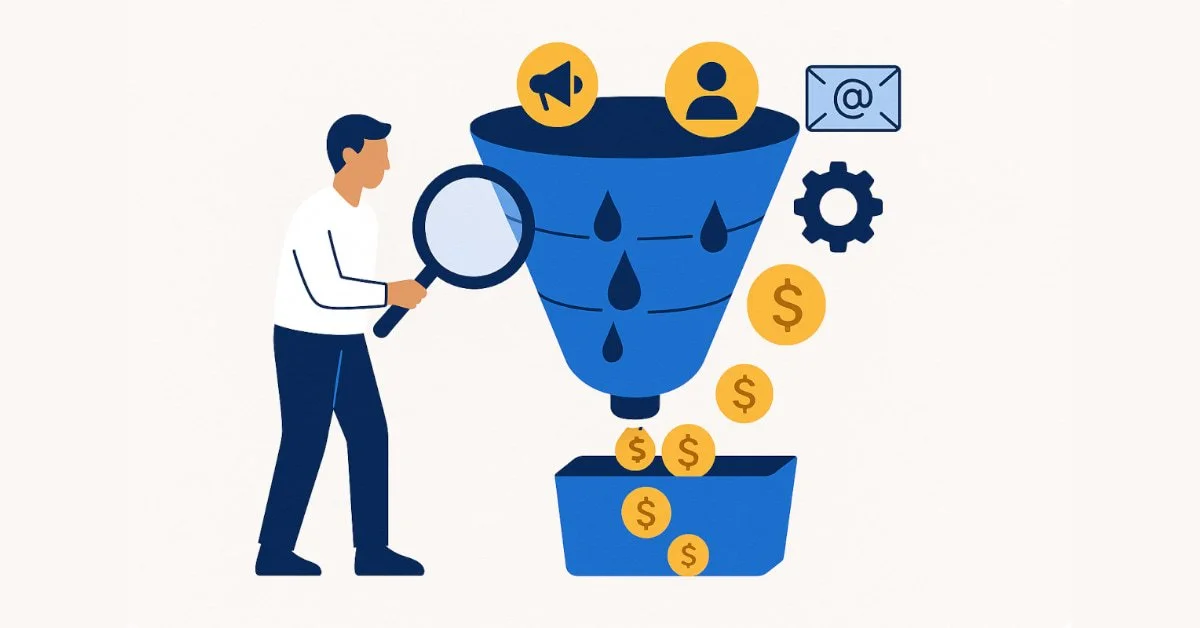How to Spot and Fix Leaks in Your Customer Lifecycle
Why Lifecycle Leaks Are Your Hidden Growth Killers
Your lifecycle marketing strategy might be costing you more than you realize. Even the most well-designed customer journeys can spring leaks, quietly draining your revenue, reducing retention, and leaving conversion potential untapped. These lifecycle leaks are the drop-off points—places where leads ghost you, customers stall, or subscribers disengage. They’re easy to miss and costly to ignore.
But the good news? Once you learn how to spot them, you can fix them. In this guide, we’ll walk through how to identify leaks in your customer lifecycle, what causes them, and the practical tactics you can use to patch the holes and drive sustainable growth.
What Are Lifecycle Leaks?
Lifecycle leaks are points in your customer journey where engagement, conversion, or retention unexpectedly drops. These are moments when a lead doesn’t convert, a new customer never returns, or an engaged user suddenly stops opening your emails.
These leaks can appear at any stage, from awareness to advocacy. They're often a signal that your messaging, timing, or experience isn’t matching your customer’s needs. Spotting them requires zooming out to look at the full journey, and zooming in to inspect each touchpoint.
Common Leak Zones in the Customer Lifecycle
The Leaky Welcome. First impressions matter. If your welcome emails underperform, it’s likely your value proposition isn’t clear, your call-to-action is weak, or your timing is off. A leaky welcome sequence means fewer subscribers become customers.
The Silent Signup. You got the lead, but then… silence. If users sign up but don’t engage, it may be due to a lack of onboarding, confusing next steps, or irrelevant follow-ups. This is especially common with SaaS and e-commerce brands relying on automated marketing solutions.
The Vanishing Buyer. Customers who purchase once and never again? That’s a post-purchase leak. It often stems from a lack of education, poor product follow-up, or a missing retention plan.
The Ghosted Cart. Cart abandonment is a textbook lifecycle leak. Without a strong abandoned cart series, backed by lifecycle email marketing, you’re leaving money on the table.
The Disengaged Subscriber. If open and click rates drop over time, you’re facing a leak in your email engagement. Often, this means your content isn’t staying relevant or segmented well.
How to Identify Lifecycle Leaks
Map Your Customer Journey. Begin by visualizing every step of your customer lifecycle, from first touch to loyal advocate. Label each stage and the actions a customer should ideally take. Tools like customer journey maps or funnel visualizations are invaluable here.
Measure Key Metrics at Every Stage. Quantify performance at each touchpoint. Look at conversion rates, email open/click rates, time to first purchase, repurchase rates, churn, and more. Benchmarking these reveals where performance dips.
Look for Drop-Off Patterns. Where are users stalling or falling off? Is there a sharp drop in engagement after email #2 in your welcome series? Are subscribers abandoning carts but never receiving a follow-up? These patterns expose the leaks.
Use Heatmaps and Session Recordings. If your site has UX issues, tools like Hotjar or FullStory can help you visualize where users are hesitating, bouncing, or scrolling past CTAs.
Interview or Survey Your Users. Sometimes, direct feedback reveals what metrics can't. Ask disengaged customers why they left. Conduct exit surveys, user interviews, or quick polls.
How to Fix Lifecycle Leaks
Revamp Your Welcome Flow. Use marketing automation strategy to craft a high-performing welcome sequence that educates, builds trust, and guides users to take action. Every email should have a clear goal and move the user forward.
Optimize Onboarding Experiences. Turn new users into active users quickly. Use product tours, triggered emails, and in-app messaging to shorten the time to value. Tailor onboarding based on user behavior or persona.
Add Post-Purchase Nurture Campaigns. Your email marketing agency should have a plan for post-purchase emails that reinforce product value, provide usage tips, and introduce complementary products. That second purchase is gold—go get it.
Strengthen Your Abandonment Flows. Don’t settle for one reminder. Build multi-email cart recovery sequences with urgency, social proof, and product images. Use A/B testing to optimize timing and copy.
Reignite Inactive Subscribers. Create re-engagement campaigns that remind users why they subscribed. Offer a surprise, ask for preferences, or run a “break-up” campaign that brings them back or clears them out.
Segment Smarter. One-size-fits-all content leads to disengagement. Use behavioral segmentation and lifecycle stage data to tailor messages. Your email campaign management should reflect how people actually behave, not how you wish they did.
Tools That Make It Easier
Don’t try to plug leaks manually at scale. Leverage marketing automation services that help you:
Build behavior-triggered journeys
Run A/B and multivariate tests
Create dynamic content based on segmentation
Track lifecycle metrics in real time
Platforms like Customer.io, Klaviyo, and Iterable offer robust automation and reporting tools that give email marketing experts the visibility and control they need.
When to Call in the Experts
If identifying and fixing lifecycle leaks feels overwhelming, you’re not alone. Many fast-growing brands turn to a lifecycle marketing agency for email marketing consulting and automated marketing solutions.
An outside perspective can help you:
Audit your lifecycle flows
Spot missed revenue opportunities
Implement a scalable marketing automation strategy
Streamline your email campaign management
Bringing in email marketing experts isn’t a cost, it’s an investment in your pipeline.
Growth Starts Where the Leaks Stop
Plugging lifecycle leaks isn’t just about patching problems, it’s about unlocking revenue and momentum. Every small improvement compounds across the entire customer journey.
If you’re ready to start fixing your lifecycle, don’t just look at surface-level metrics. Dig deeper. Map it out. Fix what’s broken. Test what’s working. And if you need a partner to help you move faster, we’re here to support you. Reach out and let’s talk.
Because lifecycle marketing done right doesn’t just acquire customers, it keeps them.

